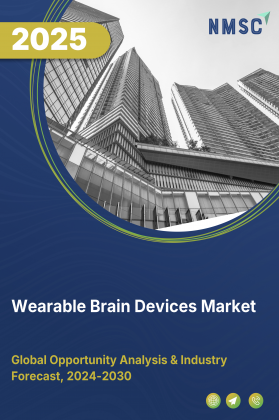
Wearable Brain Devices Market by Device Type (EEG, fNIRS, MEG, tDCS, TMS, Hybrid, and Others), by Connectivity (Wired and Wireless), by Application (Medical, Consumer Wellness, Cognitive Training, Gaming, Research, Military, and Others), by Wearing Position (Headbands, Helmets, Ear-Worn, Eyewear, and Others), by Distribution Channel (Direct, Retail, Hospitals & Medical Distributors and OEMs),– Global Opportunity Analysis and Industry Forecast, 2025–2030.
Industry Overview
The global Wearable Brain Devices Market size was valued at USD 505.4 million in 2024, and is expected to be valued at USD 667.4 million by the end of 2025. The industry is projected to grow, hitting USD 1157.6 million by 2030, with a CAGR of 11.6% between 2025 and 2030.
The growing burden of chronic diseases such as diabetes, cardiovascular, and respiratory disorders is driving the demand for wearable brain devices that support continuous health monitoring and early intervention. However, significant concerns regarding data privacy and ethics, given these devices’ ability to access sensitive cognitive information, pose challenges to widespread acceptance.
Despite these barriers, advancements in brain disease treatment and cognitive enhancement offer strong future growth opportunities, as wearable brain devices enable real-time monitoring, personalized stimulation, and cognitive performance improvement across medical and wellness applications.
Growing Burden of Chronic Diseases Fuels Market Growth
The increasing prevalence of chronic diseases such as diabetes, cardiovascular conditions, and respiratory disorders is significantly driving the demand for continuous health monitoring solutions. As these conditions often progress silently, early detection and regular monitoring have become critical for effective management.
Wearable EEG devices are emerging as valuable tools in this landscape, offering non-invasive and continuous tracking of brain activity and related physiological signals. These devices help identify early neurological symptoms associated with chronic illnesses such as stroke risk in cardiac patients or cognitive decline in individuals with diabetes.
By facilitating real-time monitoring, wearable EEGs support timely intervention, better symptom control, and reduced hospital readmissions, ultimately contributing to improved patient outcomes and more efficient healthcare management.
Emergence of Brain-Targeted Wearable Devices Expands Market Potential
The rise of brain-focused wearable devices is revolutionizing neurotechnology and mental health by enabling real-time cognitive monitoring, non-invasive brain-computer interfaces, and mood tracking. These innovations are positioning wearable EEGs as a key segment in the evolving wearable medical device market.
The OMI wearable, launched in 2025, interprets brain activity to execute digital commands, introducing a new level of hands-free interaction. SynPhNe’s device combines brain and muscle monitoring to assist in post-stroke rehabilitation. Thus, mental health and cognitive care gain importance globally, the demand for wearable solutions that address brain health is expected to grow, expanding the market’s reach across clinical, wellness, and consumer technology sectors.
Remote Monitoring and Telehealth Fuel Demand for Wearable Brain Devices
The growing implementation of remote patient monitoring and telehealth solutions is driving the wearable brain devices market growth, as healthcare systems increasingly prioritize real-time neurological data for early detection of cognitive decline, stroke risk, and mental health concerns. These devices support continuous brain activity tracking, enabling timely intervention and reducing the need for frequent hospital visits.
Remote patient monitoring is expanding due to aging populations, and this trend supports the market shift toward home-based neurorehabilitation and cognitive therapy, solidifying wearable brain devices as essential tools in modern tele-neurology care.
Privacy Concerns and Ethical Challenges Surrounding Wearable Brain Devices Hinder Market Expansion
One major restraint factor for the market is the significant privacy and ethical concerns associated with the technology. These devices have the potential to access and interpret sensitive data, such as mental states, emotions, and even memories, raising the risk of unauthorized surveillance or misuse.
As wearable brain devices offer unprecedented insight into personal cognition, their ability to monitor and manipulate the brain's activities leads to serious privacy implications. Additionally, the ethical challenges of using this technology in areas like healthcare or even consumer products remain a significant concern, particularly in ensuring that personal mental data remains protected and not exploited.
Advancement in Brain Disease Treatment and Cognitive Enhancement Creates Future Growth Opportunities
The market holds significant future opportunities in the fields of brain disease treatment and cognitive enhancement. These devices have the potential to revolutionize the management of neurological conditions such as Alzheimer's, Parkinson's, and depression. By offering real-time monitoring of brain activity and providing personalized stimulation, these devices could improve the lives of individuals living with chronic brain diseases. Moreover, advancements in neurostimulation technologies could lead to better treatments, potentially restoring brain function or slowing disease progression.
Additionally, as cognitive enhancement becomes a growing interest, wearable brain devices open new pathways for improving focus, memory, and overall cognitive performance, benefiting both medical patients and the general population. As research and development continue to advance, the market for these devices could expand significantly, with applications in healthcare, wellness, and even performance optimization.
Market Segmentation and Scope of the Study
The wearable brain devices market report is segmented by device type, connectivity, application, wearing position, distribution channel, and region. Device types include EEG-based devices, fNIRS-based, MEG-based, tDCS, TMS, hybrid devices, and others, Connectivity covers wired and wireless systems, with Bluetooth, Wi-Fi, and cellular-enabled variants enhancing mobility and real-time data use. Applications span neurological disorder management, stroke rehabilitation, depression treatment, meditation, sleep improvement, memory training, VR/AR gaming, academic research, and military alertness monitoring. Wearing positions include headbands, helmets, ear-worn devices, and smart eyewear, designed for user comfort and application specificity. Distribution channels include direct-to-consumer, retail pharmacies, hospital distributors, and OEM partnerships. Regional coverage includes North America, Europe, Asia-Pacific, Latin America, and the Middle East & Africa.
Geographical Analysis
North America leads the wearable brain devices market share due to strong research, funding, and early use of new technologies. U.S. companies like Neurable have unveiled a set of headphones to optimize focus and help users manage distractions. BrainCo have developed and launched an AI-powered headband that track users’ level of focus and engagement. Supportive regulations and growing mental health awareness help keep this region ahead in both innovation and market size.
Europe is witnessing steady growth in the market, driven by its strong emphasis on ethical standards, data privacy, and evolving healthcare demands. Countries such as Germany, the UK, and the Netherlands are at the forefront, integrating brain technologies across clinical research, cognitive therapy, and consumer wellness. The region is also fostering adoption through collaborations between neurotech startups, academic institutions, and healthcare providers.
Innovative devices like OpenBCI’s Galea Beta equipped with multi-modal sensors to track brain activity, heart rate, muscle signals, eye movement, and skin response are gaining attention in Europe for their potential in advanced human-computer interaction, mental health monitoring, and neurofeedback training. This focus on precision, regulation, and well-being positions Europe as a key contributor to the global expansion of wearable brain technologies.
The Asia-Pacific region is experiencing the fastest growth in the market, fueled by ongoing healthcare reforms, the rise of neurotech startups, and increasing public awareness about mental well-being and cognitive health. Countries like China, Japan, South Korea, and India are actively investing in brain-monitoring technologies for applications ranging from clinical diagnostics to education and gaming. In particular, India is emerging as a hub for affordable innovation, with the development and use of cost-effective EEG headbands, neurofeedback systems, and brain-training apps tailored for both urban and rural populations.
Meanwhile, the Rest of the World (RoW) including Latin America, the Middle East, and Africa is gradually entering the market, primarily through research partnerships, pilot healthcare projects, and government initiatives aimed at improving neurological care. While adoption in RoW remains in its early stages, growing interest in remote patient monitoring and mental health support is expected to accelerate demand in the coming years.
Key Players and Their Strategies in the Global Wearable Brain Devices Industry
The top key players in the industry are adopting various strategies such as product innovation, strategic partnerships, regulatory approvals, and research collaborations to strengthen their presence in the wearable brain devices space.
-
Medtronic received FDA approval in February 2025 for its BrainSense Adaptive Deep Brain Stimulation (DBS) system, designed for Parkinson’s disease. This first-of-its-kind solution adjusts stimulation in real time based on brain signals through the Percept™ neurostimulator. The integrated BrainSense Electrode Identifier streamlines electrode programming, cutting time by up to 85%, significantly improving clinical efficiency.
-
Apple showcased a range of advanced health and AI capabilities during its 2024 developer event. Updates include predictive illness detection and sleep apnea notifications enabled by accelerometer-based breathing disturbance detection, available on Apple Watch Series 9, Series 10, and Ultra 2. These features mark a deeper foray into neuro-wearable functionality, reinforcing Apple’s ambition to lead in digital health innovation.
-
Samsung entered the neuro-wearables space with the launch of the Galaxy Ring. Integrated with Galaxy AI, the device offers continuous health monitoring capabilities, including heart rate tracking, sleep analysis, and indicators relevant to neurological health. While neurophysiological functionalities are emphasized, regulatory clearance processes are still underway.
-
Garmin announced recipients of its 2024 India Research Grant, highlighting its commitment to neuroscience. One key project led by AIIMS utilizes Garmin smartwatch data and AI algorithms to detect early warning signs of epileptic seizures, aiming to prevent incidents of Sudden Unexpected Death in Epilepsy (SUDEP).
-
GE HealthCare in partnership with Biofourmis, introduced an AI-driven, wearable-based home monitoring platform for neurological and chronic patients. Launched in early 2024, the system is designed to alleviate hospital workloads while ensuring continuous, personalized care through remote clinical oversight.
Key Benefits
-
The report provides quantitative analysis and estimations of the market from 2025 to 2030, which assists in identifying the prevailing industry opportunities.
-
The study comprises a deep dive analysis of the current and future wearable brain devices market trends to depict prevalent investment pockets in the sector.
-
Information related to key drivers, restraints, and opportunities and their impact on the market is provided in the report.
-
Competitive analysis of the players, along with their market share, is provided in the report.
-
SWOT analysis and Porter's Five Forces model are elaborated in the study.
-
Value chain analysis in the market study provides a clear picture of the roles of stakeholders.
Wearable Brain Devices Market Key Segments
By Device Type
-
EEG-Based Devices
-
fNIRS-Based Devices
-
MEG-Based Devices
-
tDCS Devices
-
TMS Devices
-
Hybrid Devices
-
Others
By Connectivity
-
Wired Wearable Brain Devices
-
Wireless Wearable Brain Devices
-
Bluetooth-Enabled
-
Wi-Fi Enabled
-
Cellular / 5G Enabled
-
By Application
-
Medical & Clinical Use
-
Neurological Disorder Management
-
Stroke Rehabilitation
-
Chronic Pain Management
-
Depression & Anxiety Treatment
-
-
Consumer Wellness
-
Meditation & Mindfulness
-
Stress & Mood Tracking
-
Sleep Improvement
-
-
Cognitive Training & Learning
-
Memory Enhancement
-
Focus & Attention Improvement
-
-
Gaming & Entertainment
-
VR/AR Integration
-
Neuroadaptive Gaming
-
-
Research & Academic
-
Cognitive Neuroscience Studies
-
Experimental Brain Mapping
-
-
Military & Defense
-
Soldier Mental Alertness
-
Combat Stress Monitoring
-
-
Others
By Wearing Position
-
Headbands
-
Caps & Helmets
-
Ear-Worn Devices
-
Glasses / Smart Eyewear
-
Others
By Distribution Channel
-
Direct-to-Consumer
-
Retail Pharmacies & Electronics Stores
-
Hospitals & Medical Distributors
-
OEM Partnerships
Key Players
-
EMOTIV
-
NeuroPace, Inc.
-
BrainBit
-
Pankhtech India Private Limited
-
AAVAA Inc.
-
Cogwear, Inc.
-
Kernel
-
Muse
-
Zeto Inc.
-
BIOPAC Systems Inc.
-
Cadwell Industries Inc.
-
Neuroelectrics
-
ANT Neuro
-
Brain Products GmbH
REPORT SCOPE AND SEGMENTATION:
|
Parameters |
Details |
|
Market Size in 2025 |
USD 667.4 Million |
|
Revenue Forecast in 2030 |
USD 1157.6 Million |
|
Growth Rate |
CAGR of 11.6% from 2025 to 2030 |
|
Analysis Period |
2024–2030 |
|
Base Year Considered |
2024 |
|
Forecast Period |
2025–2030 |
|
Market Size Estimation |
Million (USD) |
|
Growth Factors |
|
|
Countries Covered |
28 |
|
Companies Profiled |
15 |
|
Market Share |
Available for 10 companies |
|
Customization Scope |
Free customization (equivalent to up to 80 working hours of analysts) after purchase. Addition or alteration to the country, regional, and segment scope. |
|
Pricing and Purchase Options |
Avail customized purchase options to meet your exact research needs. |

















 Speak to Our Analyst
Speak to Our Analyst

























